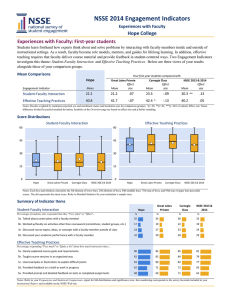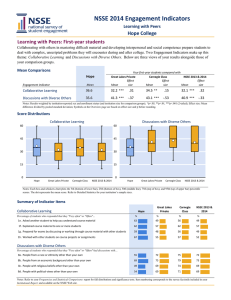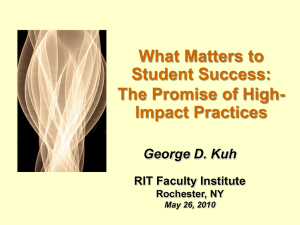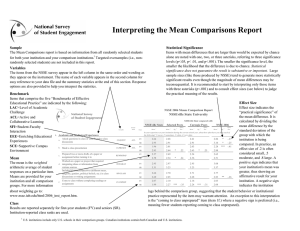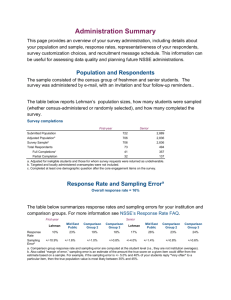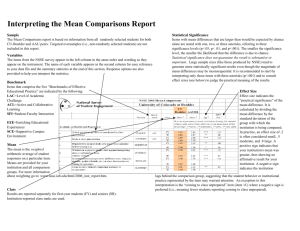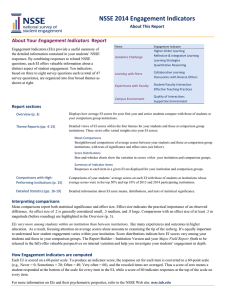NSSE 2014 Engagement Indicators Campus Environment: First-year students Hope College
advertisement
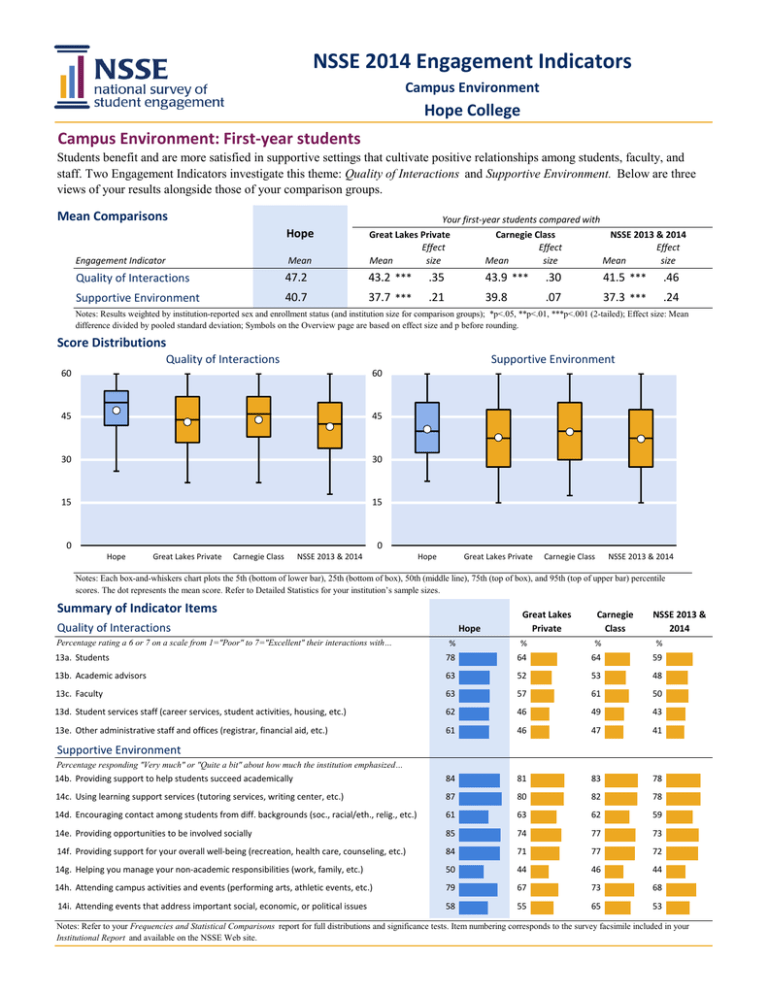
NSSE 2014 Engagement Indicators Campus Environment Hope College Campus Environment: First-year students Students benefit and are more satisfied in supportive settings that cultivate positive relationships among students, faculty, and staff. Two Engagement Indicators investigate this theme: Quality of Interactions and Supportive Environment. Below are three views of your results alongside those of your comparison groups. Mean Comparisons Engagement Indicator Mean Your first-year students compared with Great Lakes Private Carnegie Class NSSE 2013 & 2014 Effect Effect Effect Mean size Mean size Mean size Quality of Interactions 47.2 43.2 *** .35 43.9 *** .30 41.5 *** .46 Supportive Environment 40.7 37.7 *** .21 39.8 .07 37.3 *** .24 Hope Notes: Results weighted by institution-reported sex and enrollment status (and institution size for comparison groups); *p<.05, **p<.01, ***p<.001 (2-tailed); Effect size: Mean difference divided by pooled standard deviation; Symbols on the Overview page are based on effect size and p before rounding. Score Distributions Quality of Interactions Supportive Environment 60 60 45 45 30 30 15 15 0 0 Hope Great Lakes Private Carnegie Class NSSE 2013 & 2014 Hope Great Lakes Private Carnegie Class NSSE 2013 & 2014 Notes: Each box-and-whiskers chart plots the 5th (bottom of lower bar), 25th (bottom of box), 50th (middle line), 75th (top of box), and 95th (top of upper bar) percentile scores. The dot represents the mean score. Refer to Detailed Statistics for your institution’s sample sizes. Summary of Indicator Items Quality of Interactions Hope Great Lakes Private Carnegie Class NSSE 2013 & 2014 % % % % 13a. Students 78 64 64 59 13b. Academic advisors 63 52 53 48 13c. Faculty 63 57 61 50 13d. Student services staff (career services, student activities, housing, etc.) 62 46 49 43 13e. Other administrative staff and offices (registrar, financial aid, etc.) 61 46 47 41 14b. Providing support to help students succeed academically 84 81 83 78 14c. Using learning support services (tutoring services, writing center, etc.) 87 80 82 78 14d. Encouraging contact among students from diff. backgrounds (soc., racial/eth., relig., etc.) 61 63 62 59 14e. Providing opportunities to be involved socially 85 74 77 73 Percentage rating a 6 or 7 on a scale from 1="Poor" to 7="Excellent" their interactions with… Supportive Environment Percentage responding "Very much" or "Quite a bit" about how much the institution emphasized… 14f. Providing support for your overall well-being (recreation, health care, counseling, etc.) 84 71 77 72 14g. Helping you manage your non-academic responsibilities (work, family, etc.) 50 44 46 44 14h. Attending campus activities and events (performing arts, athletic events, etc.) 79 67 73 68 14i. Attending events that address important social, economic, or political issues 58 55 65 53 Notes: Refer to your Frequencies and Statistical Comparisons report for full distributions and significance tests. Item numbering corresponds to the survey facsimile included in your Institutional Report and available on the NSSE Web site. NSSE 2014 Engagement Indicators Campus Environment Hope College Campus Environment: Seniors Students benefit and are more satisfied in supportive settings that cultivate positive relationships among students, faculty, and staff. Two Engagement Indicators investigate this theme: Quality of Interactions and Supportive Environment. Below are three views of your results alongside those of your comparison groups. Mean Comparisons Hope Your seniors compared with Carnegie Class Effect Mean size Engagement Indicator Mean Great Lakes Private Effect Mean size NSSE 2013 & 2014 Effect Mean size Quality of Interactions 45.9 43.9 *** .18 44.3 ** .15 42.5 *** .29 Supportive Environment 36.7 33.9 *** .20 36.6 .01 33.3 *** .24 Notes: Results weighted by institution-reported sex and enrollment status (and institution size for comparison groups); *p<.05, **p<.01, ***p<.001 (2-tailed); Effect size: Mean difference divided by pooled standard deviation; Symbols on the Overview page are based on effect size and p before rounding. Score Distributions Quality of Interactions Supportive Environment 60 60 45 45 30 30 15 15 0 0 Hope Great Lakes Private Carnegie Class NSSE 2013 & 2014 Hope Great Lakes Private Carnegie Class NSSE 2013 & 2014 Notes: Each box-and-whiskers chart plots the 5th (bottom of lower bar), 25th (bottom of box), 50th (middle line), 75th (top of box), and 95th (top of upper bar) percentile scores. The dot represents the mean score. Refer to Detailed Statistics for your institution’s sample sizes. Summary of Indicator Items Quality of Interactions Hope Great Lakes Private Carnegie Class NSSE 2013 & 2014 % % % % 13a. Students 69 66 65 64 13b. Academic advisors 66 58 63 52 13c. Faculty 79 66 70 60 13d. Student services staff (career services, student activities, housing, etc.) 49 44 43 42 13e. Other administrative staff and offices (registrar, financial aid, etc.) 43 45 41 42 14b. Providing support to help students succeed academically 83 76 80 72 14c. Using learning support services (tutoring services, writing center, etc.) 79 70 74 67 14d. Encouraging contact among students from diff. backgrounds (soc., racial/eth., relig., etc.) 43 56 54 53 14e. Providing opportunities to be involved socially 79 67 73 66 Percentage rating a 6 or 7 on a scale from 1="Poor" to 7="Excellent" their interactions with… Supportive Environment Percentage responding "Very much" or "Quite a bit" about how much the institution emphasized… 14f. Providing support for your overall well-being (recreation, health care, counseling, etc.) 77 61 70 63 14g. Helping you manage your non-academic responsibilities (work, family, etc.) 30 33 34 32 14h. Attending campus activities and events (performing arts, athletic events, etc.) 77 57 68 57 14i. Attending events that address important social, economic, or political issues 53 49 60 46 Notes: Refer to your Frequencies and Statistical Comparisons report for full distributions and significance tests. Item numbering corresponds to the survey facsimile included in your Institutional Report and available on the NSSE Web site. 2 • NSSE 2014 ENGAGEMENT INDICATORS This page intentionally left blank. NSSE 2014 ENGAGEMENT INDICATORS • 3 Hope College 2014 Engagement Indicators Quality of Interactions 60% Hope Mean Percentile of Group Mean Distribution 100.0% 40% 20% 0% SD 9.5 12.4 100% Group Mean Standard Deviations of Hope Mean from Group Mean 7.64 60% Hope Mean Percentile of Group Mean Distribution 100.0% 100.0% 80% 0.0% 40% 0% SD 9.5 11.4 100% Group Mean Standard Deviations of Hope Mean from Group Mean 4.73 60% Hope Mean Percentile of Group Mean Distribution 100.0% Quality of Interactions Top 10% Detailed Statistics: First-Year Students SD 9.5 11.6 100% Group Mean Standard Deviations of Hope Mean from Group Mean 1.73 60% Mean 47.2 46.0 Hope Mean Percentile of Group Mean Distribution 95.8% 95.8% 80% 4.2% 40% 20% 0% Prepared by Hope College Office of Institutional Research 2/24/2015 95.8% Hope Group Mean 45.9 42.5 99.1% 0.9% 20% 0% 100% Group Mean Standard Deviations of Hope Mean from Group Mean 4.40 60% 80% 40% 100.0% 0.0% 20% 0% Quality of Interactions Top 50% Detailed Statistics: Seniors Mean 45.9 45.3 SD 9.0 11.3 100% Group Mean Standard Deviations of Hope Mean from Group Mean 0.87 60% Hope Mean Percentile of Group Mean Distribution 80.8% 0% 40% SD 9.0 11.9 Hope Group 20% 80% Quality of Interactions NSSE 2013 & 2014 Detailed Statistics: Seniors SNSUM # 3 100.0% 80% 0.0% 40% 60% Hope Mean Percentile of Group Mean Distribution 100.0% 100.0% Mean 47.2 44.0 Group Mean Standard Deviations of Hope Mean from Group Mean 2.36 Hope Group 20% Quality of Interactions Top 50% Detailed Statistics: First-Year Students Hope Group 100% SNSUM # 2 100.0% Mean 47.2 41.5 Mean 45.9 44.3 Hope Mean Percentile of Group Mean Distribution 99.1% Quality of Interactions NSSE 2013 & 2014 Detailed Statistics: First-Year Students Hope Group SD 9.0 10.4 Hope Group 99.1% Group Mean Standard Deviations of Hope Mean from Group Mean 4.94 100.0% 80% 0.0% 100.0% 100% 100.0% Mean 47.2 43.9 Quality of Interactions Carnegie Class Detailed Statistics: Seniors SNSUM # 4 80.8% 80% 19.2% 40% 80.8% SD 9.5 11.1 Hope Group SNSUM # 1 20% 0% Quality of Interactions Top 10% Detailed Statistics: Seniors SD 9.0 11.6 100% Group Mean Standard Deviations of Hope Mean from Group Mean -1.93 60% Hope Group Mean 45.9 47.4 Hope Mean Percentile of Group Mean Distribution 2.7% 2.7% 80% 97.3% 40% 20% 0% 2.7% Quality of Interactions Carnegie Class Detailed Statistics: First-Year Students Hope College 2014 Engagement Indicators Supportive Environment 60% Hope Mean Percentile of Group Mean Distribution 86.9% 40% 20% 0% SD 11.3 13.8 100% Group Mean Standard Deviations of Hope Mean from Group Mean 3.96 60% Hope Mean Percentile of Group Mean Distribution 100.0% 100.0% 80% 0.0% 40% 0% SD 11.3 13.2 100% Group Mean Standard Deviations of Hope Mean from Group Mean 1.55 60% Hope Mean Percentile of Group Mean Distribution 94.0% Supportive Environment Top 10% Detailed Statistics: First-Year Students SD 11.3 12.8 100% Group Mean Standard Deviations of Hope Mean from Group Mean -0.90 60% Mean 40.7 41.4 Hope Mean Percentile of Group Mean Distribution 18.5% 18.5% 80% 81.5% 40% 20% 0% Prepared by Hope College Office of Institutional Research 2/24/2015 18.5% Hope Group Mean 36.7 33.3 20% 0% 100% Group Mean Standard Deviations of Hope Mean from Group Mean 3.67 60% 80% 40% 100.0% 0.0% 20% 0% Supportive Environment Top 50% Detailed Statistics: Seniors Mean 36.7 36.1 SD 11.8 13.8 100% Group Mean Standard Deviations of Hope Mean from Group Mean 0.72 60% Hope Mean Percentile of Group Mean Distribution 76.3% 0% 40% SD 11.8 14.4 Hope Group 20% 56.6% 80% 43.4% Supportive Environment NSSE 2013 & 2014 Detailed Statistics: Seniors SNSUM # 3 94.0% 80% 6.0% 40% 60% Hope Mean Percentile of Group Mean Distribution 100.0% 94.0% Mean 40.7 39.4 Group Mean Standard Deviations of Hope Mean from Group Mean 0.17 Hope Group 20% Supportive Environment Top 50% Detailed Statistics: First-Year Students Hope Group 100% SNSUM # 2 100.0% Mean 40.7 37.3 Mean 36.7 36.6 Hope Mean Percentile of Group Mean Distribution 56.6% Supportive Environment NSSE 2013 & 2014 Detailed Statistics: First-Year Students Hope Group SD 11.8 13.0 Hope Group 56.6% Group Mean Standard Deviations of Hope Mean from Group Mean 1.12 86.9% 80% 13.1% 100.0% 100% 86.9% Mean 40.7 39.8 Supportive Environment Carnegie Class Detailed Statistics: Seniors SNSUM # 4 76.3% 80% 23.7% 40% 20% 76.3% SD 11.3 12.9 Hope Group SNSUM # 1 0% Supportive Environment Top 10% Detailed Statistics: Seniors SD 11.8 13.3 100% Group Mean Standard Deviations of Hope Mean from Group Mean -2.55 60% Hope Group Mean 36.7 39.0 Hope Mean Percentile of Group Mean Distribution 0.5% 0.5% 80% 99.5% 40% 20% 0% 0.5% Supportive Environment Carnegie Class Detailed Statistics: First-Year Students
